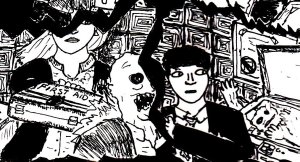Although this is an article about why you shouldn’t get jealous of the ways that other artists make art, I’m going to have to talk about when this happened to me (and how I got over it), in the hope that it might be useful to you.
Earlier this year, I was trying to get into more of an “artistic” mood. So, I decided to take a look at some art by one of my favourite artists on Youtube.
Anyway, the thing that really caught my interest was the fact that this artist had also started posting daily artwork on Instagram too. As someone who posts daily art online myself, it’s always really cool to see other artists doing this.
But, as I was looking at all of the drawings, I realised that most of them contained something that I often seemed to be lacking in my own art – spontaneity.
Thinking about it logically, I imagine that there was probably quite a lot of time, thought, planning and preparation put into each of the daily drawings in the gallery. But, from the way that they’re presented (eg: photographs of sketchbook pages), they look like brilliantly inspired drawings that were created in a fraction of the time that it takes many artists to draw a picture. They all look like they were drawn furiously in sudden moments of inspiration.
By comparison, my own daily art practice felt extremely stodgy and formal. I usually try to make most of my paintings a standard size (although this varies slightly over time) and I also usually try to ensure that most of my paintings take less than 60-90 minutes to make. When I’ve finished a painting, I scan (rather than photograph) it and then I usually edit it digitally (at minimum, this can involve cropping the picture to size and then changing the brightness, contrast and colour saturation levels).
Usually, after I’ve finished a daily painting, I’ll write two dates in the margin – the date that the painting was made and the date that it will be posted here. There’s usually a significant gap between the two dates. If I ever become famous, this will probably baffle art historians for decades.
About the closest thing to “spontaneous” that I get is when I make B&W comics like this one or this one and, even then, I usually tend to make them months in advance.
Then again, this is the kind of art practice that actually works for me. It’s something that I’ve developed over about four years of daily art practice, and it’s meant that I’ve actually been able to keep up my daily art practice.
If you’re doing something every day for a long period of time, then you will naturally gravitate towards a style of practice that works best for you. In a way, it almost becomes an expression of who you are.
It can be very easy to look at another artist’s work and conclude that they have a much better relationship with their art practice than you do with your practice. Whilst it’s probably true that successful artists have a good relationship with their art practice, what this actually looks like varies significantly from artist to artist.
So, looking at something that is right for one artist and then concluding that your own way of making art is “wrong” or “inferior” is a foolish idea. It’d be like looking at a list of someone else’s favourite foods and feeling bad because your own favourite foods are different.
My own way of making art may not be very “spontaneous”, but it’s what works for me. If I tried to be “spontaneous”, then I’d probably produce art that I didn’t really like. I’d constantly be rushing around in a panic and trying to make art within much shorter deadlines than I’m used to. After a few weeks or months, I’d probably end up either going back to my old “not spontaneous” style or I’d just stop making art.
My own way of making art is something that has developed alongside me and it is uniquely suited to me. With enough time and practice, your own way of making art will become uniquely suited to you.
And, if you’re still feeling discouraged about the fact that there are better artists out there than you, then remember that there are also worse artists out there too. Even the artists that you think are better than you probably think that their own art isn’t as good as the art that their favourite artists make.
If you don’t believe me, then just take a look at the front page of a popular art website called DeviantART. If you look at the newest updates on there for a while, you’ll see both better and worse artwork than your own art.
So, the next time you see another artist’s work online and you think something like “they’re so much more spontaneous than I am“, “they make art every day! Every day!” or “they focus on detail a lot more than I do“, just remember that they’re using a practice style that works for them. It might not work for you.
————–
Anyway, I hope that this was useful 🙂








